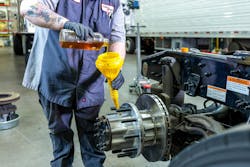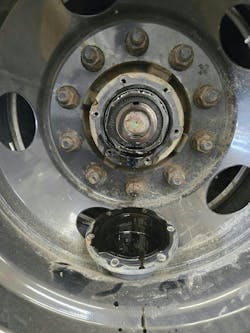Key Highlights
- Inadequate training and rushed work can lead to improper installation, contamination, and component failure in wheel-ends.
- Common causes of failure include incorrect seal installation, bad bearing adjustment, and insufficient lubrication, which can cause leaks and bearing damage.
- Industry standards like TMC Recommended Practices and the 2-1-1 method help ensure proper wheel bearing adjustment and component replacement.
- Using the correct tools, such as OEM-specific seal drivers and calibrated torque wrenches, is crucial for effective and safe repairs.
- Continuous technician training is necessary to keep up with industry changes and reduce the risk of costly wheel-end failures.
While wheel-ends may be messy work, they still demand precision. Without proper training or attention, mistakes are bound to happen.
“The last thing anybody wants to work on on a trailer is a wheel-end because you’ve got to take tires and wheels off, the brake drum off, take the hub off,” said Billy Turner, a former fleet owner in Oklahoma who invented the TetherTech Wheel Safety system. “It’s nasty, greasy, hot. They don’t want to do that job in the first place. So in a lot of shops, what happens is the least qualified tech gets put on the most crucial part of the trailer."
This can mean cutting corners and a lack of attention to detail that fleets can’t afford. Improper installation, contamination, overloading, and lack of lubrication are all avoidable mistakes that can lead to leaky seals and loose bearings.
But at the same time, junior techs often take the role on because it’s less complicated than tracing upstream aftertreatment issues.
“There’s a shortage of trained technicians in our industry, and they’re pressed to get the job done,” said Bob Fogal, president and CEO of IMI Products. “I think in terms of wheel-ends, oftentimes they’re hurried and not given a lot of time to fully go through a process for proper wheel inspection [or maintenance], which ties directly to the safety of those vehicles out on the roads.”
While keeping wheel-ends operating as they should has a lot to do with proper maintenance procedures and inspection, it has just as much to do with constant, quality technician training.
“Don’t assume that because your technicians took a training class five years ago that everything’s still the same,” emphasized Brian Beathard, co-founder and principal at RevHD. “The industry is changing rapidly.”
Training up on the components likely to fail is a good start.
Beathard said the most commonly cited issues are seal leaks and damage to the hub or hub cap, which can allow for loss of lubricant or lubricant contamination, and bearing failure or misalignment. Seals in particular deserve special attention by design, since they are meant to sound the alarm when something needs attention, he explained, noting the seal is designed to be the “weakest link in the chain.”
And when it comes to seal failure, he explained that incorrect installation is usually the culprit, which could include anything from a bad spindle shoulder to using the wrong tool.
“You shouldn’t use a STEMCO tool to put in a National seal and vice versa,” Beathard explained. “The tools are really designed in a way that they can harm another manufacturer’s seal.”
R.I.S.T. Method
- Remove debris from mating surfaces
- Inspect components for damage
- Snug the lug nuts in a star pattern
- Torque all lug nuts to specification
(Source: Tire Industry Association)
Another leading cause of seal failure is bad bearing adjustment. Beathard explained this can be the result of the plethora of options available on the market today when it comes to different nuts, hubs, and configurations, making it tough for technicians to memorize proper procedures.
“Whatever [the technician] looked up or was told to be the correct bearing adjustment on the previous spindle they worked on, they’ll assume that’s going to work on the next one,” he said, “Especially if it’s the same make and model.”
This isn’t always the case.
“We’ve seen makes and models change from year to year,” he cautioned. “A 2019 tractor might call for 500 ft.-lbs. on the steer. The next one you look at that’s a 2020 might call for 300 ft.-lbs. If you do 500 ft.-lbs. on a hub that’s only requiring 300, you’re going to have big issues.”
Beathard said most seals on the market are built to last five years minimum, but their lifespan can be impacted by additional factors like the age of the equipment, whether it operates off-road or over-the-road, what is being hauled, and more.
Bearings are another critical point of failure, and misalignment can quickly end up costing fleets in downtime and potential safety issues down the line.
“There are only two contact points on that wheel, and that’s your outer bearing and your inner bearing,” Turner explained, “and when you run those bearings out of alignment by having end play in them, you get all kinds of movement in your wheel. You get that tire wear, seals go out, ABS light issues—all the things that the truck industry deals with right now on a daily basis.”
Other common service-related issues revolve around improper lubrication, according to Jason Galbraith, national service manager at ConMet.
“At times, technicians fail to get the correct amount of semi-fluid grease or oil into the wheel-end, which can result in a wheel-end failure relatively quickly,” he said. “It’s important to understand the fill volume requirements of wheel-ends given the type of lubricant being used.”
Recommended practices and tools
Industry standards provide most of the guidelines for wheel-end maintenance and best practices. The Tire Industry Association’s R.I.S.T. method should always be followed.
R.I.S.T. Method
- Remove debris from mating surfaces
- Inspect components for damage
- Snug the lug nuts in a star pattern
- Torque all lug nuts to specification
For more detailed guidance, turn to the Technology & Maintenance Council's Recommended Practices. These include RP 618 for wheel bearing adjustments; RP 622 for wheel seal and bearing removal and replacement; RP 631 for wheel-end lubrication; and RP 644 to evaluate damage to hubs, bearings, nuts, seals, and spindles.
The 2-1-1 method is also generally accepted for wheel bearing adjustment, and stands for 200 ft.-lbs. first, back the nut off until it’s loose, go back with 100 ft.-lbs., and then back off one hash mark, outlined Brian Beathard, co-founder and principal at RevHD. The standardized process ensures that bearings are seated properly without being too loose or too tight.
However, as with most maintenance processes, these best practices aren’t the final word, and the required tools and training depend on the specific requirements for the wheel-end system being used, advised Hendrickson’s Greg Dvorchak.
Tools required for wheel-end repairs or rebuilds are relatively consistent, and a typical tool kit might include:
- Spindle nut sockets
- Calibrated torque wrenches
- Dial or digital endplay gages
- Standard hex keys or screwdrivers
- Correct/OEM-specific seal driver
Galbraith also recommends having a set of forged sockets and a stud installation tool on-site.
“Forged sockets are robust and designed to handle a wide range of torque. This is especially important when working on components that require higher torque, such as axle nuts,” he said, while a stud installation tool helps prevent stud and hub damage when doing stud replacements.
About the Author

Lucas Roberto
Lucas Roberto is an Associate Editor for Fleet Maintenance magazine. He has written and produced multimedia content over the past few years and is a newcomer to the commercial vehicle industry. He holds a bachelor's in media production and a master's in communication from High Point University in North Carolina.

